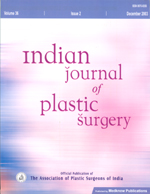
|
Indian Journal of Plastic Surgery
Medknow Publications on behalf of Indian Journal of Plastic Surgery
ISSN: 0970-0358
EISSN: 0970-0358
Vol. 41, No. 1, 2008, pp. 51-54
|
 Bioline Code: pl08010
Bioline Code: pl08010
Full paper language: English
Document type: Short Communication
Document available free of charge
|
|
|
Indian Journal of Plastic Surgery, Vol. 41, No. 1, 2008, pp. 51-54
| en |
Silicone Foley's catheter: A useful splint in ear surgeries
Karanth, Siddharth K & Mokal, Nitin J
Abstract
Maintenance of ear projection and post auricular sulcus in staged ear reconstruction in microtia is a trying problem. So also is the maintenance of the patency of the external auditory meatus following recanalization and meatoplasty. Numerous splints and dressing techniques have been described for the above situations. Some of the problems encountered include the availability of the materials, cost, expertise in fabrication and compliance.
Aims: To devise a simple, reliable, inexpensive and readily available splint for the maintenance of post auricular sulcus and external auditory meatus opening.
Settings and Design: A silicone catheter is made out of a soft and inert material that doesn′t cause tissue necrosis or any loss of skin graft. The basic design is that of a simple, self-retaining type of splint that doesn′t dislodge and can be prepared within minutes on the operating table.
Materials and Methods: This splint has been used in four cases of microtia reconstruction and one case of congenital external auditory meatus stenosis between June 2006 and August 2007. A 14 or 16 Fr silicone Foley′s catheter was used. The proximal end of a catheter of required length was retained and the distal part was cut off. The catheter was looped into a circle around the base of the reconstructed ear and secured in position with a suture. A similar construct was used in cases of external auditory meatus reconstruction or recanalization. The funnel-shaped distal drainage end was sutured to the circular frame near the region of the tragus. This funnel was inserted into the external auditory canal.
Results: The catheter was found to sit snugly in the newly created sulcus, thereby maintaining the sulcus and ear projection. It aided in maintaining the meatal opening of a satisfactory diameter in the case of external auditory canal recanalization. It was never found to slip or get dislodged in any of the cases. There was no skin graft loss or tissue necrosis due to the use of the splint.
Conclusions: The silicone Foley′s catheter is found to be a simple, readily available, inexpensive and reliable self-retaining splint following ear elevation in microtia and external auditory meatus recanalization. The catheter is easily constructed and applied intraoperatively. The results following its usage have been uniformly good in all cases without causing any adverse events at the operated site or discomfort to the patient ensuring good compliance.
Keywords
External auditory meatal stenosis, microtia, silicone Foley′s catheter
|
| |
© Copyright 2008 Indian Journal of Plastic Surgery.
Alternative site location: http://www.ijps.org/
|
|
